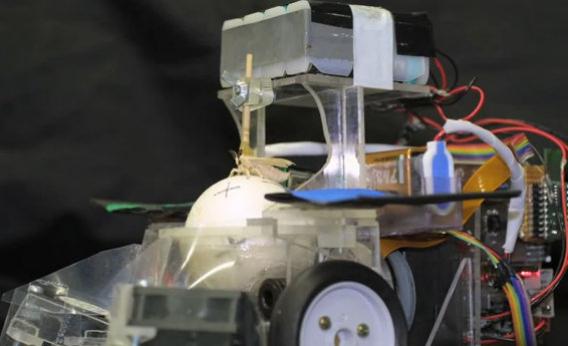Of Course Japanese Researchers Made a Robot Car for Moths To Drive

Still from YouTube.
Every Friday, Future Tense rounds up the best robot videos of the week. Seen a great robot video? Tweet it to @FutureTenseNow, or email us.
In this week’s videos, a moth goes for a ride, a robot sparks explosions, and a new opponent hits the badminton court.
The Moth Bot
Japan is home to some extremely necessary and some unbelievably weird robots. This one falls firmly into the latter category. Developed at the University of Tokyo, the device is essentially a car for moths. It was built to study how moths work their way toward a female sex pheromone. The goal is to apply lessons from this project to broader robotic sensory systems, especially ones that could be used to detect sources of chemical leaks. Current electronic sensors take a long time to determine what chemicals they’re detecting, and they’re not able to pick up on odors at all. Noriyasu Ando, the lead researcher on this project, tells ExtremeTech that the moth test will help apply insect sensory systems to robotics. It’s worth noting that the moths were incredible drivers. Each test subject steered the robot by walking on a Styrofoam ball similar to a computer mouse’s trackball. The moths made their way to the pheromones and couldn’t be stopped even when the device was rigged to throw them off course. So there you have it: a robot that lets moths drive their way to sex. What’s left to explain?
Via the Atlantic.
The Fiery Bot
Want more adrenaline-pumping action from robots? How about more explosions? This squishy robot from Harvard ignites combustible gas to launch itself into the air. It’s not exactly like that scene in Die Hard 2, but with a mixture of methane and oxygen, plus a small spark, this thing can launch itself up to 30 times its height. Soft, flexible robots like this one are typically controlled by compressed air. Pumping air into different chambers of the body allows a decent range of motions, though it’s rather slow and limited. The extra firepower in this version can give the bot quite a boost when it moves, and researchers are looking for ways to get more control from these tiny explosions.
Via the New Scientist.
The Blind Juggler Bots
Here’s a nice visual demonstration of the power of mathematics. These machines were designed to keep balls in the air at specified heights, but they have no way to actually see or track the balls. Instead, they rely on algorithms to make sure the balls hit the plates at the right time and place. The algorithms compensate for unpredictable variables, so flaws in the balls’ design or disturbances in the air won’t throw the system off track. The first Blind Juggler was built by Philipp Reist at the Swiss Federal Institute of Technology-Zurich. Reist describes the projects as an exploration of chaos (in terms of chaos theory) and how to find control within it. Researchers on the Blind Juggler projects say their work could help future robots navigate the world, and until then I’d guess it’s quite the rush to push the machine’s “chaos” button just to see what happens.
Watch on Reuters.
The Badminton Bot
It’s not always easy to find a partner for a rousing game of badminton. But instead of giving up and just watching it on TV (or something?), researchers at the Flanders’ Mechatronics Technology Center in Belgium built their own opponent. The device uses two cameras to track the shuttlecock, then it slides along a court-wide rail to hit the birdie back to the other side. With response times at just a fraction of a second, it can intercept the shuttlecock at speeds up to nearly 250 mph. The developers chose badminton because it’s a new territory for robotics, and it gives anybody who’s interested a chance play against the machine.
Via Euronews.
Extra Bits
Stop freaking out about robots taking your job. It’s not happening any time soon. More from the Atlantic.
British troops in Afghanistan are deploying tiny helicopter drones that give any soldier an eye in the sky. Weighing just 16 grams, the Black Hornet is already giving soldiers a peek into dangerous areas before they venture in. More from IEEE Spectrum.
Five seconds and a soft T-shirt will clean any iPad screen, but for some reason there’s a robot that takes eight minutes to do the same thing. More from Gizmodo.
Future Tense is a partnership of Slate, New America, and Arizona State University.
